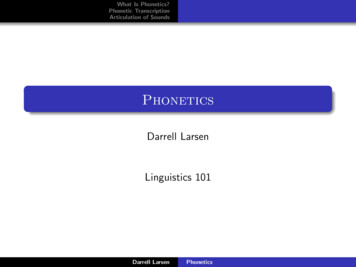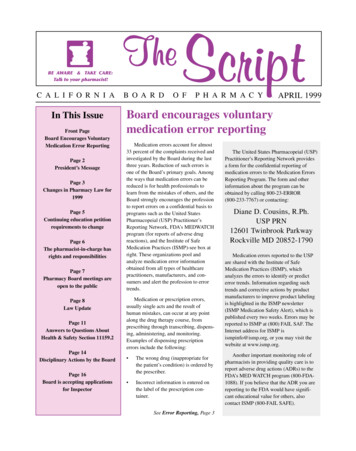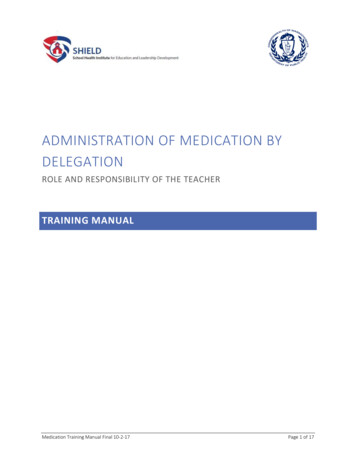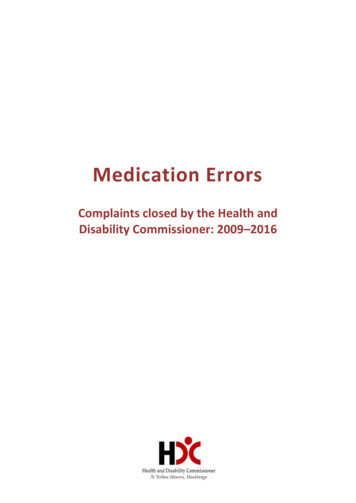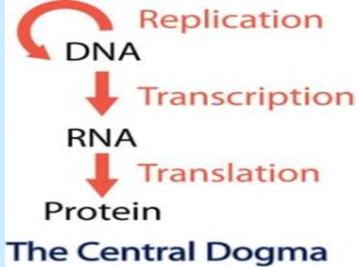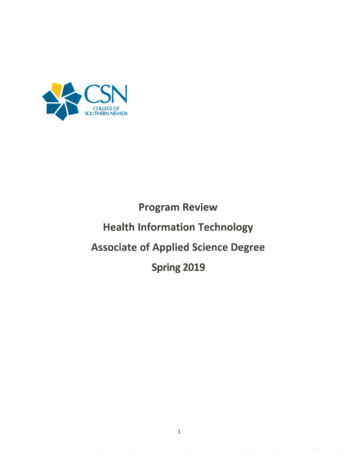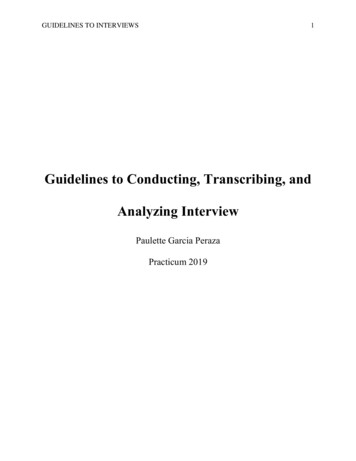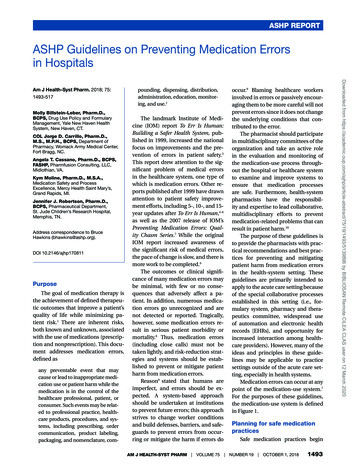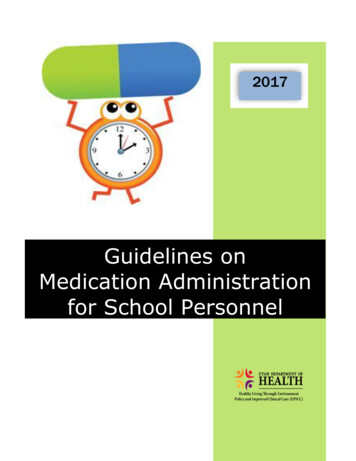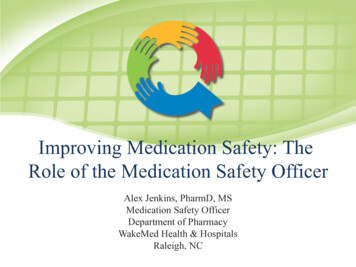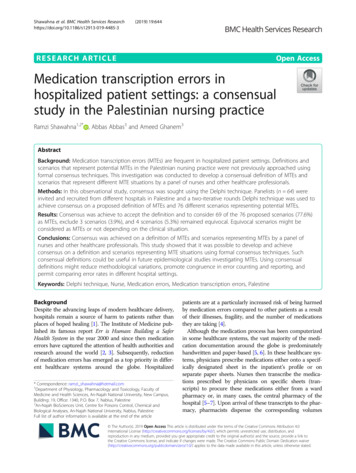
Transcription
Shawahna et al. BMC Health Services 2019) 19:644RESEARCH ARTICLEOpen AccessMedication transcription errors inhospitalized patient settings: a consensualstudy in the Palestinian nursing practiceRamzi Shawahna1,2* , Abbas Abbas3 and Ameed Ghanem3AbstractBackground: Medication transcription errors (MTEs) are frequent in hospitalized patient settings. Definitions andscenarios that represent potential MTEs in the Palestinian nursing practice were not previously approached usingformal consensus techniques. This investigation was conducted to develop a consensual definition of MTEs andscenarios that represent different MTE situations by a panel of nurses and other healthcare professionals.Methods: In this observational study, consensus was sought using the Delphi technique. Panelists (n 64) wereinvited and recruited from different hospitals in Palestine and a two-iterative rounds Delphi technique was used toachieve consensus on a proposed definition of MTEs and 76 different scenarios representing potential MTEs.Results: Consensus was achieve to accept the definition and to consider 69 of the 76 proposed scenarios (77.6%)as MTEs, exclude 3 scenarios (3.9%), and 4 scenarios (5.3%) remained equivocal. Equivocal scenarios might beconsidered as MTEs or not depending on the clinical situation.Conclusions: Consensus was achieved on a definition of MTEs and scenarios representing MTEs by a panel ofnurses and other healthcare professionals. This study showed that it was possible to develop and achieveconsensus on a definition and scenarios representing MTE situations using formal consensus techniques. Suchconsensual definitions could be useful in future epidemiological studies investigating MTEs. Using consensualdefinitions might reduce methodological variations, promote congruence in error counting and reporting, andpermit comparing error rates in different hospital settings.Keywords: Delphi technique, Nurse, Medication errors, Medication transcription errors, PalestineBackgroundDespite the advancing leaps of modern healthcare delivery,hospitals remain a source of harm to patients rather thanplaces of hoped healing [1]. The Institute of Medicine published its famous report Err is Human: Building a SaferHealth System in the year 2000 and since then medicationerrors have captured the attention of health authorities andresearch around the world [2, 3]. Subsequently, reductionof medication errors has emerged as a top priority in different healthcare systems around the globe. Hospitalized* Correspondence: ramzi shawahna@hotmail.com1Department of Physiology, Pharmacology and Toxicology, Faculty ofMedicine and Health Sciences, An-Najah National University, New Campus,Building: 19, Office: 1340, P.O. Box 7, Nablus, Palestine2An-Najah BioSciences Unit, Centre for Poisons Control, Chemical andBiological Analyses, An-Najah National University, Nablus, PalestineFull list of author information is available at the end of the articlepatients are at a particularly increased risk of being harmedby medication errors compared to other patients as a resultof their illnesses, fragility, and the number of medicationsthey are taking [4].Although the medication process has been computerizedin some healthcare systems, the vast majority of the medication documentation around the globe is predominatelyhandwritten and paper-based [5, 6]. In these healthcare systems, physicians prescribe medications either onto a specifically designated sheet in the inpatient’s profile or onseparate paper sheets. Nurses then transcribe the medications prescribed by physicians on specific sheets (transcripts) to procure these medications either from a wardpharmacy or, in many cases, the central pharmacy of thehospital [5–7]. Upon arrival of these transcripts to the pharmacy, pharmacists dispense the corresponding volumes The Author(s). 2019 Open Access This article is distributed under the terms of the Creative Commons Attribution 4.0International License (http://creativecommons.org/licenses/by/4.0/), which permits unrestricted use, distribution, andreproduction in any medium, provided you give appropriate credit to the original author(s) and the source, provide a link tothe Creative Commons license, and indicate if changes were made. The Creative Commons Public Domain Dedication o/1.0/) applies to the data made available in this article, unless otherwise stated.
Shawahna et al. BMC Health Services Research(2019) 19:644and doses of the prescribed medications. Medications arethen distributed and administered to the patients concerned. Patients to whom medications were administeredmight be monitored for the therapeutic action of the medication, allergy, side effects, and/or medication’s concentration in their blood. Therefore, a medication error mighttake place during any phase of this multi-phase process.Medication errors occur during the prescription, transcription, dispensing, administration, and/or monitoring phase[5, 8–10]. Previous studies focused on the medication errors that occur during the prescription and/or administration stage [1, 7, 9–11]. Little attention was paid towards theerrors occurring at the transcription stage.Medication transcription errors (MTEs) are of particularimportance because the different phases of prescription,transcription, dispensing, and administration occur in chainand, therefore, it is highly likely that if a medication wastranscribed incorrectly, this error would go without interception and would most probably reach the patient andcause harm. Previous studies conducted in Switzerland,Pakistan, and Iran and showed that errors occurred at themedication transcription phase [5, 7, 11]. In a previousstudy conducted in Pakistan, MTEs occurred in 16.9 and13.8% of the 6583 and 5329 medications transcribed ontoinpatient profiles and discharge charts, respectively [5].Pichon et al. conducted a study in Switzerland in which thenurses transcribed chemotherapy and non-chemotherapyrelated prescribed medications onto different sheets twice[7]. In the first transcription stage, 11.8 and 20.7% of thetranscribed chemotherapy and non-chemotherapy medications, respectively, were incorrect. Fahimi et al. reviewedMTEs in a teaching hospital in Iran and MTEs occurred inabout 30% of the 558 opportunities for errors [11]. It isnoteworthy mentioning that in large hospitals where largervolumes of medications are prescribed which subsequentlyneed to be transcribed before being dispensed and administered to patients, even lower error rates are of paramountimportance given the increasing opportunities for errorsand potential harms to the patients [12].Medication errors are defined differently and manydefinition of medication errors were previously reported[13–15]. Obviously, methodological variation in definingwhat constitutes a medication error might have a significant impact on the error rates researchers disseminatein their studies reporting on medication errors [8, 9, 16,17]. Researchers might use different definitions or scenarios representing medication error situations whichultimately would lead to variability in error rates reported in their studies. Therefore, defining medicationerrors is a step of paramount importance in analyzingthe incidence and prevalence of medication errors in aparticular setting. Formal consensus techniques havebeen used to reduce discrepancies in what constitutes amedication error and to achieve consensus on definitionsPage 2 of 12and scenarios representing error situations. Formal consensus methods were used to define medication prescription, administration and dispensing errors [8, 9, 16, 17].However, these techniques were not used to develop andachieve consensus on a definition of MTEs and scenariosthat represent different MTE situations.The aim of this study was to develop a definition ofMTE and achieve consensus on this definition and thedifferent scenarios that represent MTE situations by apanel of nurses and other healthcare professionals usingthe Delphi technique.MethodsDefining MTEs and formulating scenarios representingerror situationsBefore attempting to define MTEs, the literature wassearched for different definitions of MTEs. Previous studies defined MTEs as errors that occur at the transcriptionstage that involve deviation while transcribing medicationorders from the previous prescribing step [5]. Anotherstudy defined MTEs as incomplete and/or wrong transcription of a medication order [7]. Garcia-Ramos andBaldominos Utrilla described MTEs as when the medication prescription did not match with what was transcribedon the nurse’s administration form [18]. In Fahimi et al.,MTEs were defined as deviations in transcription of medication orders from the previous step, this could occur onan order sheet, notes, and/or documentations in the pharmacy database [11]. Finally, Lisby et al. defined MTEs asdiscrepancies in the names of the drugs, their formulations, routes of administration, doses, dosing regimens,omission of drugs, or addition of drugs which were not ordered or prescribed [19].We approached and interviewed 10 key contact nurseswith extensive experience in medication transcription.The key contacts were asked open-ended questions todefine MTEs and provide potential MTE situations. Definitions and potential MTE situations were noted. Themedication process in the Palestinian healthcare systemas well as in the majority of healthcare systems in theworld is still handwritten and paper-based. Therefore,we aimed to propose a definition of handwritten MTEs.Based on the previous definitions of MTEs found in theliterature and the definitions proposed by the key contacts interviewed in this study, a definition of MTEs wasrephrased and proposed. In this definition a handwrittenMTE was defined as “any discrepancy between the physician medication order and the medication order transcribed onto any document related to the patientconcerned as the medical record, medication chart, medication request sheet, discharge medication chart and/orany other similar document”.We then conducted an extensive literature review tocollect all potential MTE situations [5–7, 11, 14, 15, 19].
Shawahna et al. BMC Health Services Research(2019) 19:644It is important to note also that we formulated some potential MTE situations based on other forms of medication errors like prescribing, administration, anddispensing errors [1, 4, 8–10, 12, 16, 17]. A total of 76different potential MTE situation were collected. Potential MTE situations were transformed into scenarios andincluded into a questionnaire. The questionnaire wasgiven to 5 healthcare professionals in a pilot to assess itsreadability and comprehensibility. The 5 healthcare professionals were not included in the subsequent Delphirounds. Some scenarios were revised to enhance understanding as suggested by the healthcare professionalswho took part in the pilot.The Delphi techniqueIn this study, we used the Delphi technique to developand achieve consensus on a definition of MTEs and scenarios that represent different MTE situations. The Delphi technique was extensively used in developing andachieving consensus on inconclusive issues in healthcare[8, 9, 20–27]. Moreover, this technique was used in developing and achieving consensus on other forms ofmedication errors [8, 9, 16, 17]. The Delphi techniqueinvolves iterative rounds in which panelists express thedegree to which they agree or disagree with items presented to them during the Delphi rounds. In each iterative round, panelists are given statistical summaries ofthe precedent round to help achieve consensus in theleast number of rounds.PanelistsIn this study, the panelists were purposively invited andrecruited as in previous studies [8, 9, 16, 17]. As a prerequisite of the Delphi technique, the panelist shouldpossess previous knowledge of the subject being investigated, therefore, in this study the panelists were chosenand invited on the merits of their academic qualifications and practical experience in the field of medicationtranscription. Because transcription of medication iswithin the purview of nurses, the majority of the invitedand recruited panelists in this study was purposivelynurses. The panelists were recruited from major governmental, private, and teaching hospitals in Palestine. Sixtyfour panelists were invited and recruited into the panelusing personal contacts. The panel size used in thisstudy was in the range of panels used in previous studiesconducted to define other forms of medication errors [8,9, 16, 17]. The inclusion criteria were as follows: 1) basicor advanced degree in one of the disciplines of healthcare (nursing, medicine, or pharmacy), 2) had a licenseto practice in Palestine, 3) been in practice for 5 or moreyears in a hospital setting, and 4) had been previouslytrained in minimization of medication errors and/or riskmanagement. In this study, we intended to includePage 3 of 12panelists from both genders, representative of differentage groups, living and practicing in different geographical locations, practicing in different settings, offeringdifferent services, having different clinical specialties,and having different hierarchal positions. This study wasconducted without any incentives.First iterative Delphi roundIn the first iterative Delphi round, the questionnaires weredelivered by hand to the 64 panelists. The questionnairescontained 4 parts. In the 1st part, the panelists were askedto give their demographic and practice details. In the 2ndpart, the panelists were asked if: 1) their institutions surveilled MTEs, 2) their institutions encouraged reportingMTEs, 3) their current institutions regularly instructed/trained staff to minimize MTEs, and 4) they believed theinstructions/training provided by their institutions weresufficient to reduce MTEs. The 3rd part contained theproposed definition of MTEs and panelists were asked toexpress the level of their agreement or disagreement withthe proposed definition on a Likert scale of 9 points (1 indicated total disagreement and 9 indicated total agreement). The 4th part contained the 76 scenariosrepresenting potential MTE situations and panelists wereasked to express the level of their agreement or disagreement with each scenario on a Likert scale of 9 points (1indicated total disagreement and 9 indicated total agreement). We encouraged the panelists to include writtencomments if they wished to justify and/or qualify theirscores. The questionnaire used in the Delphi rounds isshown in Additional file 1 (additional files).Analysis of the scoresScores collected in the First Delphi round were enteredin an EXCEL sheet (Microsoft Excel 2007) and their descriptive statistics were calculated. For all scores, the firstquartile (Q1), median (Q2), third quartile (Q3), and interquartile (IQR) were computed. Scores were analyzed usingthe definitions specified in the previous studies [8, 9, 16,17]. Briefly, consensus was said to have been achieved andthe definition or scenario was rejected when the medianscore was in the range of 1–3 and the IQR was within therange of 0–2. Consensus was said to have been achievedand the definition or scenario was accepted when the median score was in the range of 7–9 and the IQR was in therange of 0–2. However, in case the median score was inthe range of 4–6 or the IQR was more than 2, the definition or scenario was considered equivocal. Equivocal scenarios were included in the subsequent Delphi round.Second Delphi roundIn the second Delphi round, scenarios that were considered equivocal were included and the panelists wereasked if they wished to reconsider their scores in view of
Shawahna et al. BMC Health Services Research(2019) 19:644the scores and comments of the other panelists. Thepanelists were reminded with their own scores given inthe previous round, the median and IQR of the scores ofother panelists and a summary of their comments.Scores obtained in the second Delphi round were analyzed using the same definitions of consensus used inthe first Delphi round. We decided not to conduct athird Delphi round because it was highly likely that noconsensus would be achieved as indicated from thescores and comments of the panelists.Ethical considerationsThe ethical approval to conduct this study was obtainedfrom the Institutional Review Board (IRB) Committee ofAn-Najah National University (Protocol approval # 121Jan-2016). In this study, the panelists had to respond toitems in a questionnaire, therefore, the IRB decided thata written consent was not necessary and panelists wouldneed to provide verbal consent. All panelists providedverbal consents before participation. The Delphi technique is semi-anonymous technique in which the identity of the panelists is known to the researcher whileeach panelist remained anonymous to the remainder ofthe participants. Views and votes of panelists weighedequally during analysis.ResultsDemographic and practice details of the panelistsIn this study, responses were obtained from the 64 panelists in the first Delphi round (response rate 100%)and from 52 panelists in the second Delphi round (response rate 81.3%). The detailed demographic andpractice characteristics of all panelists are shown inTable 1.Approximately 80% (51) of the panelists were staffnurses and 13% (8) were physicians. Around 72% (46) ofthe participants worked in governmental hospitals.Nearly 61% (39) belonged to the age group 24–35 yearsold and about 52% (33) had a BSc degree. About 55%(35) of the panelists were male and about 45% (29) had anumber of years in practice in the range of 5–9 years.MTEs surveillance systems in their institutionsWhen asked if there was any medication surveillancesystem in their current institutions, approximately 60%(38) stated that such systems did not exist. Consistently,about 52% (33) stated that their institutions did not encourage reporting MTEs and about the same percentageindicated that they did not receive clear instructionsand/or training on how to minimize MTEs in their institutions. Approximately 61% (39) of the panelists did notbelieve that instructions and/or training in place wereenough to minimize MTEs. Table 2 shows the detaileddistribution of their responses.Page 4 of 12Table 1 Demographic and practice details of the panelists (n 64) who took part in the studyPanelistsNumberPercentage of total 650 and above812.5GenderAge 12.5Head nurse34.7Staff nurse5179.7Physician812.5Pharmacist/risk manager23.1Governmental hospital4671.9Private hospital1421.9Teaching hospital46.32945.3Job titleEmployerExperience (years)5–910–141828.115 and above1726.6BSc Bachelor of Science, MD Doctor of Medicine, PhD Doctor of PhilosophyDefinition of MTEsWhen asked to indicate the degree to which they disagree or agree with the proposed definition of MTEs ona scale of 1–9, consensus was achieved to accept theproposed definition that a handwritten MTE can be defined as “any discrepancy between the physician medication order and the medication order transcribed ontoany document related to the patient concerned as themedical record, medication chart, medication requestsheet, discharge medication chart or any other similardocument”. The median score was 9 and the IQR was 1.Scenarios that represent different MTE situationsAnalysis of the scores obtained in the first Delphi roundshowed that consensus was achieved to consider 59 ofthe 76 potential scenarios as MTE situations. Analysis ofthe scores obtained in the second Delphi round showedthat consensus was achieved to consider further 10 scenarios as MTE situations. The 69 of the 76 (77.6%)
Shawahna et al. BMC Health Services Research(2019) 19:644Table 2 Detailed distribution of responses of the panelists (n 64) on items related to MTEs surveillance systems in theirinstitutionsItemResponse s3148.4No3351.6Yes2539.1No3960.9Is there any MTE surveillancesystem in your current institution?Does your current institutionencourage MTE reporting?Do you receive clear instructionsand/or training from the managementof your institution to minimize MTEs?Do you think that the instructionsand/or training in place are enoughto reduce MTEs?MTEs Medication transcription errorsscenarios that were considered as MTE situations areshown in Table 3.Scenarios that were not included as MTE situations orremained equivocalAnalysis of the scores obtained in the second Delphiround showed that consensus was achieved to exclude 3scenarios (3.9%) from the list of MTEs. The 3 excludedscenarios are shown in Table 4.A total of 4 scenarios (5.3%) remained equivocal thatwere judged to be considered as MTE situations or notdepending on the individual clinical situation whichmight necessitate an evaluation on case by case basis.The 4 scenarios are shown in Table 5.DiscussionCounting MTEs and reporting error rates depend on thedefinition of errors used. Inclusion of a larger number ofsituations considered as MTEs could lead to a largernumber of errors and subsequently error rate. Previousstudies addressed MTEs using definitions either developed by the researchers themselves or adopted from another study. All potential scenarios representing MTEsituations were not previously included in a single study.Some scenarios potentially representing MTE situationswere divisive among researchers. Numbers and/or rates oferrors can be affected by the definition of errors used, detection method, counting method, and scenarios consideredPage 5 of 12as error situations. These methodological variabilities canseverely affect congruence in counting and reporting errors.They can also hamper comparing the numbers and rates oferrors reported in different settings or counted at differentoccasions or by different auditors. In this study, a definitionand scenarios that should or should not be considered asMTE situations were approached by a formal consensustechnique. Formal consensus was achieved to accept thedeveloped definition, 69 scenarios were formally consideredas MTEs, and 3 scenarios were not considered as MTEs.To the best of our knowledge, this is the first study inwhich MTEs are addressed using a formal consensustechnique.In the current study, we used a purposive samplingtechnique to recruit the panelists. This technique wascommonly used in similar studies as prior knowledge ofthe subject being investigated is an essential inclusioncriterion [8, 9, 16, 17, 26]. Although purposive samplinghas been regarded as biased in conservative views, stillthe use of other randomized sampling technique was notpossible given the nature of the study [26, 28, 29]. However, the panelists included had prior knowledge ofMTEs. Because transcription of the medications prescribed is often performed by nurses, MTEs are mostlikely to be committed by nurses. In this study, the majority of the panelists included were nurses. Nurses whocommit medication errors are often blamed, disciplined,litigated, and/or might lose their jobs [9, 30]. Therefore,we believe nurses are more concerned with MTEs thanother healthcare professionals. However, the panel included physicians, pharmacists, and risk managers.The panel size used in this study was larger than thoseused in previous similar studies [8, 9, 16, 17]. Presently,there is no agreement on the ideal number of panelists inthe Delphi technique. Panels used in previous studiesranged in size from 10 to over 1000 [28]. The Delphi technique was preferred over other formal consensus methodslike nominal and focused groups because it maintains theanonymity of the panelists, panelists from different geographical locations can be recruited and included, reducesefforts and costs of bringing the panelists together, and reduces the possibility of one or more participants to dominate the discussion as could happen in other techniqueswhere participants get together [28, 31].In this study, nearly 60% of the panelists stated thatthere was no surveillance system for MTEs in theircurrent institutions. These findings were not surprisingand were concordant with those reported in our previous study in which about 44% of the study participantsstated that there was no error surveillance system formedication administration errors in their establishments[9]. Installation of such error reporting systems wasshown to be effective in reducing errors rates [32].About half of the participants stated that their current
Shawahna et al. BMC Health Services Research(2019) 19:644Page 6 of 12Table 3 Scenarios considered as MTE situations#ScenarioRound 1Round 2MedianIQRMedianIQRThe nurse transcribed a different item than theone prescribed or failed to transcribe a prescribed item1Transcribing a completely different medication;e.g. ibuprofen instead of metronidazole9.00.00nana2Transcribing a look-like medication; e.g.motilium instead of movalis9.00.00nana3Transcribing a sound-like medication; e.g.sintrom instead of centrum9.01.00nana4Failure to transcribe the dose of a medicationthat was prescribed to the patient9.01.00nanaThe nurse transcribed a different dose, frequency,dosage form or count of the prescribed item5Transcribing micrograms into milligrams or vice versa9.02.00nana6Transcribing 0.x mL into x mL or vice versa9.00.25nana7Transcribing x.0 mg or x.0 mL into 0 mg or 0 mL or vice versa9.02.00nana8Transcribing a dose of medication thatis lower than the dose prescribed9.02.00nana9Transcribing a dose of medication thatis higher than the dose prescribed9.01.00nana10Transcribing a smaller number ofdose units than prescribed8.52.00nana11Transcribing a larger number ofdose units than prescribed9.01.00nana12Transcribing a dosage form that isdifferent from the one prescribed; e.g.capsules instead of suppositories or vice versa8.02.00nana13Transcribing a release form that is differentfrom the one prescribed; e.g. a modified releaseformulation instead of conventional or vice versa8.02.00nana14Failure to transcribe the frequency atwhich the drug was prescribed to be given9.01.00nana15Transcribing a frequency of medicationadministration that is lower than the oneprescribed; e.g. two times a day insteadof three times a day8.51.00nana16Transcribing a frequency of medicationadministration that is higher than theone prescribed; e.g. three times a dayinstead of two times a day9.01.00nanaThe nurse failed to transcribe or transcribedincorrect essential information related tothe prescribed item17Failure to transcribe prescribed instructionsto administer a medication in relation to meals7.04.007.02.018Transcribing prescribed instructions to administera medication before meal for a medication thatwas prescribed to be administered after meal or vice versa8.02.00nana19Failure to transcribe prescribed noteson how to administer a medication8.02.00nana20Failure to transcribe the prescribedthe maximum daily dose of a medicationthat was prescribed to be administered when required8.02.00nana21Failure to transcribe prescribed notes8.02.00nana
Shawahna et al. BMC Health Services Research(2019) 19:644Page 7 of 12Table 3 Scenarios considered as MTE situations (Continued)#ScenarioRound 1Round 2MedianIQRMedianIQRpertaining to special warnings or precautionsconcerning the administration of a medication22Failure to transcribe prescribed special instructionspertaining to avoiding certain foods along withthe prescribed medication8.02.00nana23Failure to transcribe prescribed special instructionspertaining to avoiding certain drugs along withthe prescribed medication8.52.00nana24Failure to re-transcribe a medication order in fullwhen a change has been made to it9.02.00nana25Failure to transcribe prescribed instructionspertaining to when to start administeringa medication8.02.00nana26Failure to transcribe prescribed instructionspertaining to when to stop administeringa medication8.02.00nana27Failure to transcribe aprescribed medication9.00.25nana28Transcribing a medicationthat was not prescribed9.00.25nana29Transcribing a medication basedon an expired medication order9.01.00nana30Transcribing a medicationthat was put on hold8.02.00nana31Transcribing a medicationthat was cancelled9.01.00nana32Transcribing a wrong date8.02.00nana33Transcribing a wrong ward7.02.00nana34Transcribing a wrong patient name9.00.00nana35Failure to transcribe prescribed specialinstructions pertaining to storage conditionsof a medication7.52.00nana36Failure to transcribe prescribed instructionsto use special measuring tools to measurethe dose of medication to be administered8.02.00nana37Failure to transcribe prescribed specialinstructions on how to reconstitute(prepare) a medication8.02.00nana38Failure to transcribe prescribed specialinstructions to disinfect a vial beforeadministration of a medication8.02.258.01.339Transcribing a route of drugadministration that is differentto that prescribed9.01.00nana40Transcribing a site of drug administrationthat was different to that prescribed8.03.008.02.041Transcribing a medication order twice7.03.007.02.042Transcribing a misspelled medication’sname (major), the medication can beconfused with another9.01.00nana43Transcribing a medication order illegibly9.02.00nana44Transcribing a medication order usingabbreviations or non-standard nomenclature8.02.258.02.0
Shawahna et al. BMC Health Services Research(2019) 19:644Page 8 of 12Table 3 Scenarios considered as MTE situations (Continued)#ScenarioRound 1Round 2MedianIQRMedianIQR45Failure to transcribe a prescribedduration for an intravenous infusion8.02.00nana46In case the prescriber made a medicationorder for a patient on mg/kg basis andprescribed instructions to calculate the dose,failure to transcribe the finally calculated doseof medication on the patient’s documents7.05.007.02.047In case the prescriber made a medicationorder for a patient with renal impairmentand prescr
Medication transcription errors (MTEs) are of particular importance because the different phases of prescription, transcription, dispensing, and administration occur in chain . MTEs were defined as deviations in transcription of medi-cation orders from the previous step, this could occur on an order sheet, notes, and/or documentations in the .
